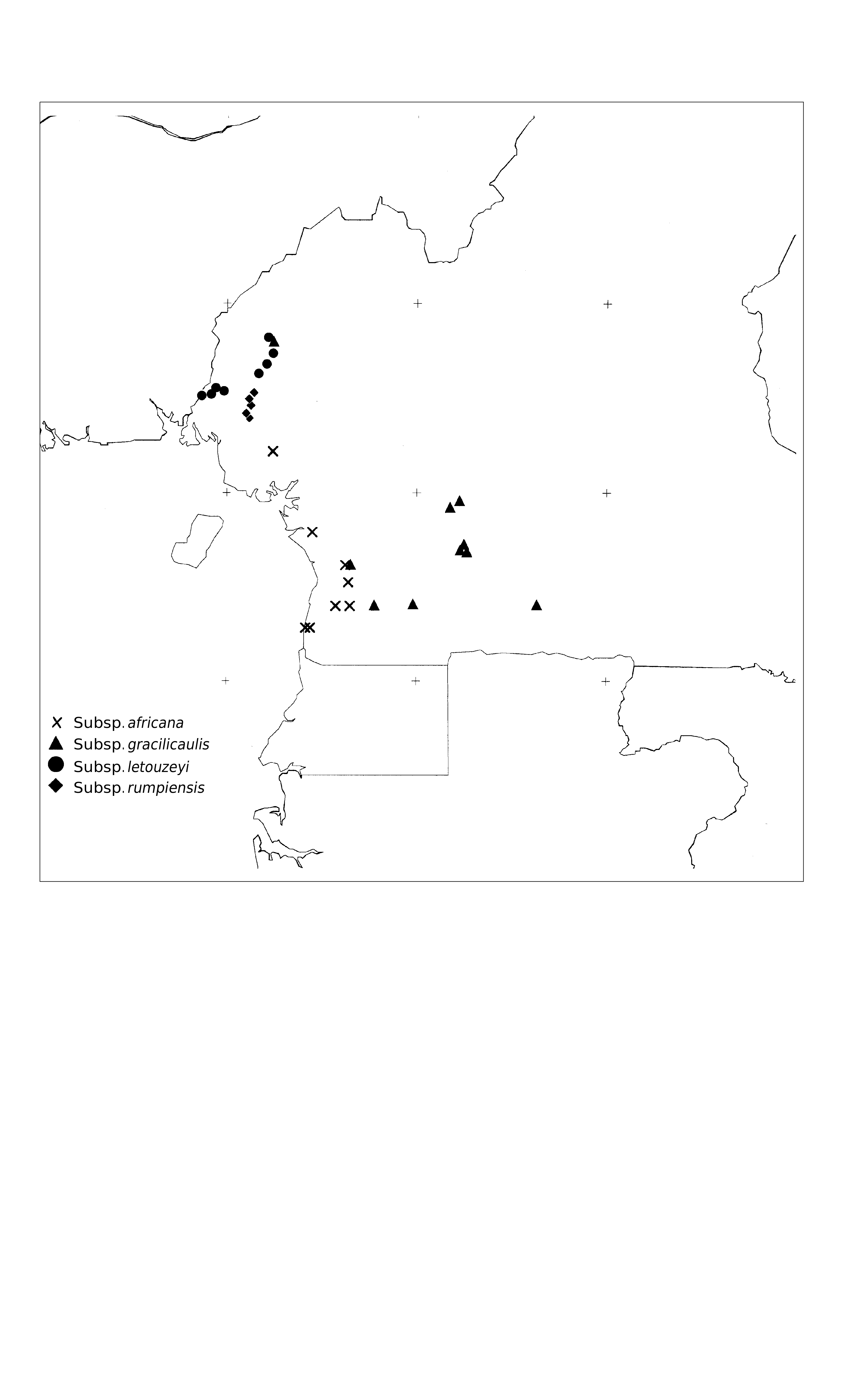Leonardoxa africana subsp. rumpiensis McKey, 2000
|
publication ID |
https://doi.org/10.5281/zenodo.4605796 |
|
DOI |
https://doi.org/10.5281/zenodo.15657408 |
|
persistent identifier |
https://treatment.plazi.org/id/03E6A435-FFA1-FFDC-C0BD-763DA8B259C4 |
|
treatment provided by |
Carolina |
|
scientific name |
Leonardoxa africana subsp. rumpiensis McKey |
| status |
subsp. nov. |
3. Leonardoxa africana subsp. rumpiensis McKey View in CoL , subsp. nov. (= group 2)
Haec subspecies Leonardoxae africanae subsp. letouzeyi perarcte affinis, sed ab ea glandulis nectariferis crateriformibus majoribus ac quoad numerum plus constantibus (ad foliola proximalia plerumque nullis ad duabus) atque foliolis utroque rhachidis latere plerumque duobus distinguitur.
TYPUS. — Letouzey 14577, Cameroon, Southwest Province, Dikome Balue, 4°55’N, 9°15’E, 35 km NNW Kumba , 1200 m, 24 Mar. 1976 ( holo-, P; GoogleMaps iso-, K, YA). GoogleMaps
Small tree, to 14 m tall. Trunk to 35 cm diam. Young shoots produced in flushes consisting of (1-)2-3 internodes plus young leaves at each branch tip (in adult trees) ( Fig. 7 View Fig ). Internodes of young twigs (3-)5.5(-11) cm long, modified as myrmecodomatia, swollen, with thick pith; twigs (3-)4(-5) mm diam. at apex tapering to ca. 2-3 mm diam. at base of internode; enlarged pith extending throughout section of twig produced in a single growth flush; ant-cavities each 2-3 internodes long (in adult trees). Swollen internodes absent in seedlings, present only in plants ≥ 50 cm tall. Prostoma of ant-domatia at apex of terminal internode of each flush of growth, opposite leaf insertion, roughly spherical in shape. Leaves 2 (-3)-jugate ( Fig. 9 View Fig ). Leaflets elliptic, falcate, apex acuminate to long-acuminate, smallest ones (proximal pair) (6.5-)16(-28) cm long and (2.7-) 6.5(-11) cm broad, largest leaflets (second pair) (7-)17.5(-30) cm long and (3-)7(-12) cm broad. Nectary glands of intermediate size (smooth gland surface oblong, about 1 × 0.75 mm, not surrounded by a raised ring of tissue), usually 2(0-5) on proximal leaflets ( Fig. 5 View Fig ), (0-)1(-2) on other leaflets. Racemes short (axis 3-5 cm long), with> 40-60 flowers, axillary on twigs 4-5 mm diam., also sometimes cauliflorous (on trunk up to 10 cm diam.). Flowers 1.8-3 cm diam.; pedicels 0.3-0.5 cm long; calyx colour unknown, sepals 0.8-1.1 cm long; petals mauve-pink to purple, 0.9-1.3 cm long. Ovule number unknown. Size of mature fruit unknown.
This subspecies is also a myrmecophyte; all trees possess swollen hollow internodes occupied by ants. As mentioned above, L. africana subsp. rumpiensis shares a number of traits with subsp. letouzeyi that distinguish these two from subsp. africana . It is distinguished from subsp. letouzeyi by its usually 2-jugate leaves ( Fig. 9 View Fig ), the smaller size of its leaflets and stems, the constancy in nectary number, and its restriction to piedmont and submontane forest (above 500 m and probably more commonly above 800 m).
DISTRIBUTION. — This taxon occurs in the Rumpi Hills ( Figs. 3 View Fig , 4 View Fig ), where it was studied in 5 field sites. Herbarium specimens from three other sites in the Rumpi Hills (see below) also appear to belong here. Material of myrmecophytic L. africana collected from submontane forest on another hill in the Southwest Province ( Letouzey 13632 [K, P, YA], from a 960 m hill 55 km southwest of Mamfe) is tentatively placed in this subspecies.
ECOLOGY. — This myrmecophyte, in contrast to the two preceding subspecies, is restricted to submontane forest (and lowland forest transitional to it: “piedmont” [ THOMAS 1995]). As in the other myrmecophytes, internodes are hollowed and occupied by ants, and each adult tree is occupied by a single ant colony. In contrast to the two preceding subspecies, each of which is principally associated with one (or two) ant species, a diverse array of ant species occupy trees in populations of the subspecies rumpiensis (D. MCKEY and R. SNELLING, unpubl. results). Nature of the interactions with ants has not been studied in this subspecies. This subspecies was termed “ L. africana taxon T2” by CHENUIL & MCKEY (1996).
PARATYPES. — CAMEROON, Southwest Province: Steep hillside, 400-850 m, 5 km W of Esukutang Village, D.W. Thomas et al. 7988 ( MO); forest, 500 m, near Masaka-Batanga , D. W. Thomas & Namata 7746 ( MO); forest, 500 m, near Meta village , Nemba et al. 753 ( MO); colline, 960 m (près côte 897) E of piste Abakpa-Mbiofong, 55km SW Mamfe , Letouzey 13632 ( K, P, YA) .
| MO |
Missouri Botanical Garden |
| E |
Royal Botanic Garden Edinburgh |
No known copyright restrictions apply. See Agosti, D., Egloff, W., 2009. Taxonomic information exchange and copyright: the Plazi approach. BMC Research Notes 2009, 2:53 for further explanation.
|
Kingdom |
|
|
Phylum |
|
|
Class |
|
|
Order |
|
|
Family |
|
|
Genus |





